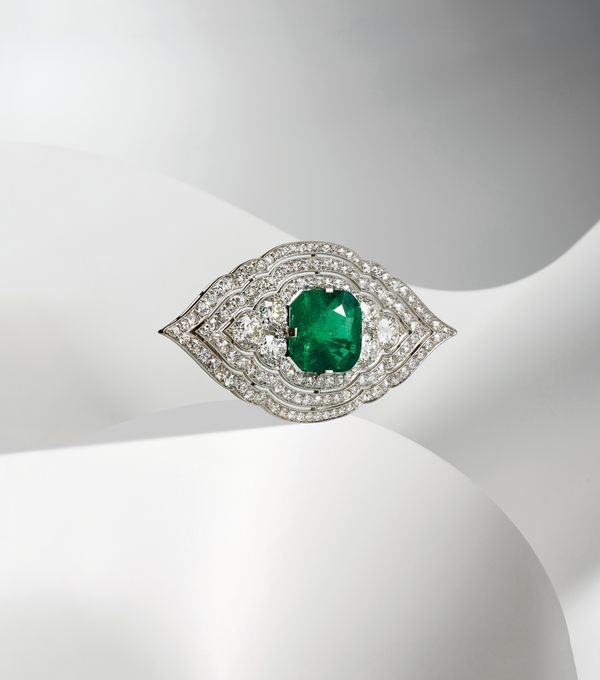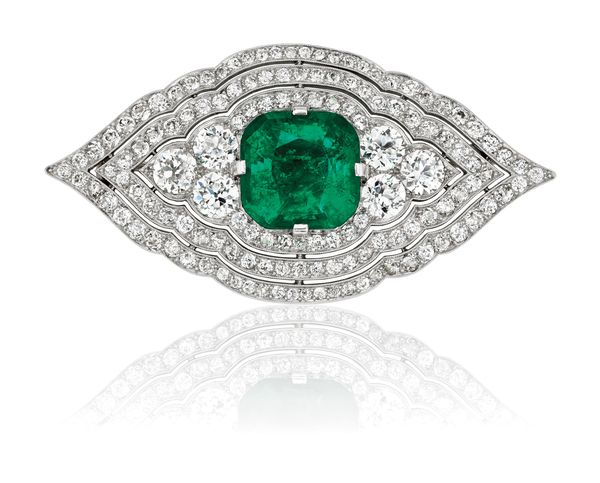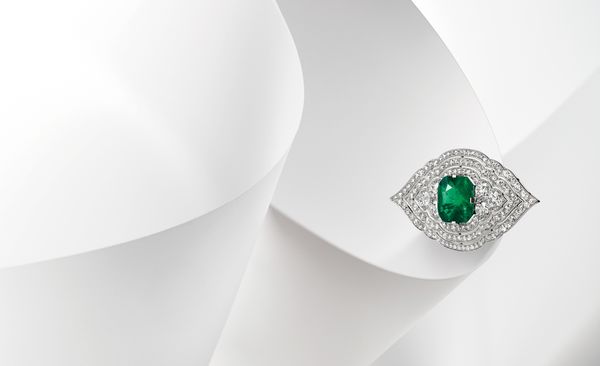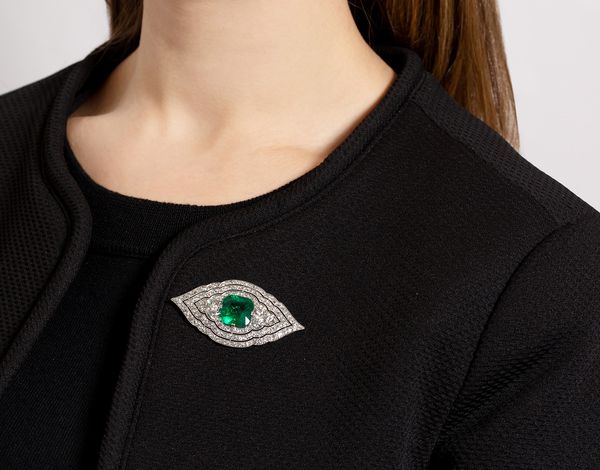Cartier Art Deco Emerald, Diamond and Platinum Brooch
By the turn of the 20th century, Cartier was already a well-established jewelry house, offering a wide range of jewelry to international clientele. The next two decades were marked by enormous growth and creativity as the desire for magnificent and splendid creations increased with the growing number of affluent patrons, newly moneyed tycoons, royalty and performers. The world was changing, and the evolution of design and fashion were deeply interwoven into this new modern realm.
This vigorous growth was matched by expansion and the relocation of Cartier's branches – the Paris office moved to a grander building at the apex of couture and jaoillierie. Three years later in 1902, the London office opened to cater to the English nobility, which coincided with numerous orders for the coronation of Edward VII. By 1909, the London office relocated to New Bond Street, and the New York branch opened to meet the needs of American clients and the increasing number of millionaires. Strategically planned and extended visits to Russia and India helped reach new clients by creating the opportunity to sell and buy jewelry, purchase ancient and rare artifacts, as well as assist the Maharajas with the transformation of their old jewelry into current fashion.
Initially, the Paris workshops supplied both the London and New York offices until local workshops were established. Later, it was the Paris and London workshops that supplied the New York branch until approximately 1917. Unlike the London branch, which was supervised by English jewelers, the first New York workshop employed all French jewelers. Each country and workshop had a different system for signing their jewelry. The pieces created in New York bear only the Cartier signature in capital letters and numbers, as assay marks were not required.
Advances in technology permitted a revolutionary change of style. Platinum, the new metal, gave lightness and flexibility, a perfect medium for the favored bows, wreaths and swags of belle époque colorless diamond and pearl set jewelry. Led by Cartier, these Louis XV-inspired creations slowly gave way to a new vernacular in jewelry. Jewels of the Art Deco era were characterized by bold geometric patterns, color, texture and rich exoticism infused from Persian, Indian, Oriental, Russian and Egyptian influences.
Parisian designer Charles Jacqueau was one of the pivotal figures at Cartier, responsible for this dynamic change of jewelry design. Jacqueau worked for more than twenty years alongside Louis Cartier. Together they spurred each other’s creativity, exploring beyond the formal constraints of design to create a fantastic new paradigm influenced by stimuli from exotic cultures. Indian and Persian miniatures inspired stylized plant patterns, as did the central medallion of Persian carpets. These forms would reappear abstracted and tempered by color and texture, sometimes further embellished with ancient artifacts.
Jewels of the Art Deco era were characterized by...rich exoticism infused from Persian, Indian, Oriental, Russian and Egyptian influences.
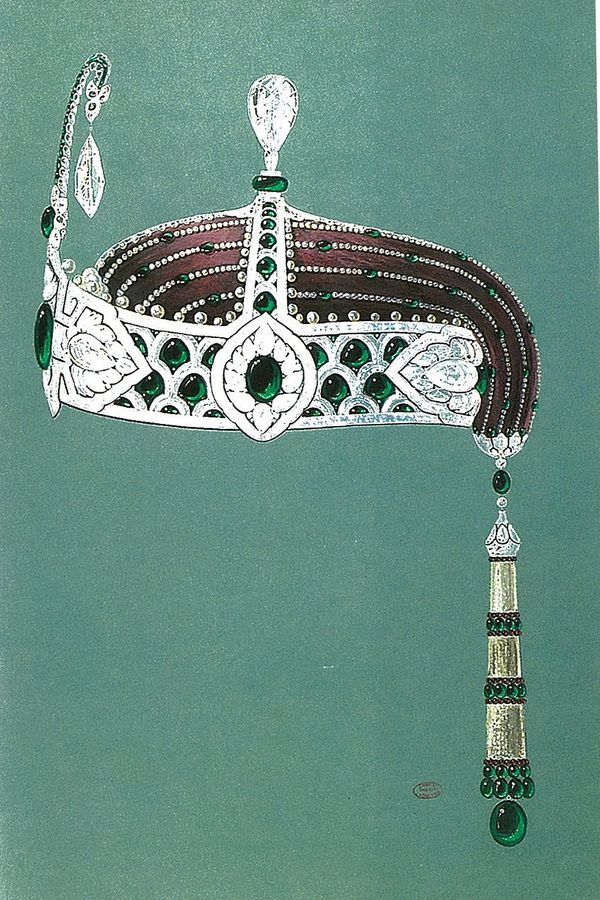
Illustration of a headdress with tassel, designed in the Persian style by Charles Jacqueau. Private collection, mid-1930s. Pen and ink, watercolor and bodycolor on gray paper drawing. Image from Cartier: 1900-1939 by Judy Rudoe, published in 1997 by The Trustees of the British Museum.
This diamond and emerald brooch from our upcoming Jewels auction in New York is a rare and beautiful example of work by Cartier from this fertile and creative period. The outline of the brooch is Persian inspired. Perhaps its origins can be traced from Louis Cartier’s personal Persian miniature collection, which was then transformed by Jacqueau into a jewel. Alternatively, the brooch may have derived from any number of exhibitions in Paris on Islamic art. A drawing in pen and ink by Jacqueau, circa 1912, shows similar ideas for brooches. Two later sketches by Jacqueau, for a headdress with tassel, depicts this reoccurring emerald and diamond motif. Undoubtedly, this was not only a popular theme but a favorite color combination, which harkens to remodeling of Indian jewels that were dominated by important Colombian emeralds which had been collected in the 1700s.
The exact date of purchase from Cartier New York is not known, although the brooch has remained in the family until today. It was most likely purchased by Peter Winchester Rouss, son of Charles Broadway Rouss of New York. According to family history, this brooch originally belonged to Peter’s wife, Ellen Swan Rouss. Based on the design, mounting and cut of stones utilized in this impressive brooch, it may have been purchased to be worn on the occasion of marriage for one of their three children in 1916, 1918 or 1923.
Few of these early American jewels produced by Cartier New York survive...
Charles Broadway Rouss was a self-made millionaire. Arriving in New York City after the Civil War, he built a successful international business as a merchant. In fact, the original building he erected in 1889 still stands and bears his name. Upon his death, Charles left his son a vast fortune and real estate, including his home at 632 Fifth Avenue, only one block south of the Plant Mansion, which was later sold to Cartier in a historic exchange for a natural pearl necklace.
Both Charles Rouss and his son Peter Winchester Rouss were colorful men. Peter Winchester Rouss, was considered flamboyant, with a real thirst for speed and excitement, which manifested itself in horse racing and yachts. For example, the sale of his four-speed yachts, each titled Winchester, involved relationships with some of the most important names in New York society and naturally on Cartier’s ledger: Leeds, Astor and Guggenheim.
Brooches of this size and design reflected the current fashion. They were worn against a diaphanous column-form dress, pinned at the neckline or near the dropped waste, or alternatively on a hat. Few of these early American jewels produced by Cartier New York survive, which makes this a rare and beautiful example of the bygone era.
